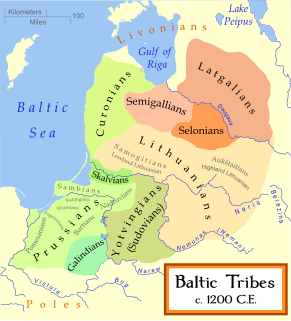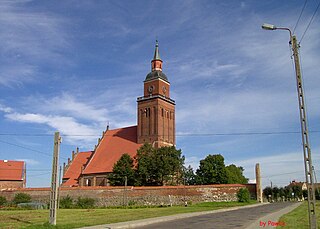
Diwanus (also Diwan, Diwane) was the leader (capitaneus) of the Bartians, one of the Prussian clans, during the Great Prussian Uprising (1260–1274) against the Teutonic Knights. [1] He was son of Kleckis (Old Prussian: bear) and therefore is sometimes referred to by a nickname derived from the word bear. [2]

The Bartians were an Old Prussian tribe who were among the last pagans of Europe before the Northern Crusades forced their conversion to Christianity. They lived in Bartia, a territory that stretched from the middle and lower flow of Łyna river, by the Świna river, and Lake Mamry, up to the Galindian woods. The territory is quite precisely known from description in Chronicon terrae Prussiae, dated 1326.

Old Prussians or Baltic Prussians refers to the indigenous peoples from a cluster of Baltic tribes that inhabited the region of Prussia. This region lent its name to the later state of Prussia. It was located on the south-eastern shore of the Baltic Sea between the Vistula Lagoon to the west and the Curonian Lagoon to the east. The people spoke a language now known as Old Prussian and followed pagan Prussian mythology.
His first major victory came when Schippenbeil fell in 1263 after almost three years of siege. Twenty knights and their men sallied out to fight the joint forces of Batians and Sudovians in an open battle. However, the pagans blocked escape routes and all Teutons were killed. [3] In terms of knights killed, it was one of the top ten losses by the Teutonic Knights during the 13th century. [4] The garrison at Schippenbeil was left with too few soldiers and supplies to withstand the siege and escaped through Galindia to Masovia. Diwanus expected that fugitives would take a shorter route north to Balga or Königsberg, therefore the knights had a head start. Diwanus soon learned about the true route and, with a handful of his best men, hurried to pursue the fugitives. During a charge on the escapees, Bartians killed three knights, but Diwanus was seriously injured. [3]

Sępopol is a town in Bartoszyce County, Warmian-Masurian Voivodeship, Poland, with 2,013 inhabitants in 2016.

Galindians were two distinct, and now extinct, tribes of the Balts. Most commonly, Galindians refers to the Western Galindians who lived in the southeast part of Prussia. Less commonly, it is used for a tribe that lived in the area of what is today Moscow.

Balga was a medieval castle of the Teutonic Knights in Kaliningrad Oblast, Russia. The castle ruins are located on the shore of the Vistula Lagoon, north of Mamonovo in the Pogranichny municipality of Bagrationovsky District, about 30 km (19 mi) southwest of Kaliningrad.
Since all major Teutonic castles in Bartia fell, Bartians did not have the need to safeguard their land from potential attacks from Teutonic strongholds. They were free to send men to help other Prussian clans. Diwanus and his men were making minor expeditions into Pogesania and Chełmno Land. In 1271, a major campaign was organized together with Pogesanian leader Linko. [2] The Bartian infantry and Pogesanians besieged a border castle, but were fended off by the Knights from Christburg. The Prussians, who managed to escape, joined their cavalry while the Knights set up their camp on the opposite bank of the Dzierzgoń River, blocking the route home. When Christians retired for the night, one half of the Prussian army crossed the river in a distance, in order to attack the Knights from the rear, while the other half charged straight across the river. The Knights were encircled. [5] The Battle of Paganstin saw twelve knights and 500 men killed. The Prussians immediately assaulted Christburg and almost captured it. The Prussians were still looting the surrounding area when cavalry from Elbing arrived. Many of the Prussian infantry perished while cavalry escaped. Despite these losses, Diwanus was soon back and blocked roads leading to Christburg hoping to starve the castle. Three times the Knights tried to send supplies to the castle via the Dzierzgoń River, and each time the vessels were intercepted by the Bartians. However, Christburg refused to surrender. [5]

Pogesanians were one of the eleven Prussian clans mentioned by Peter von Dusburg. The clan lived in Pogesania, a small territory stretched between the Elbląg and Pasłęka rivers. It is now located in the Warmian-Masurian Voivodeship, northern Poland. Pogesanians, as the rest of the Prussians, were conquered by the Teutonic Knights and became Germanized or polonized. The old Prussian language became extinct sometime in the 17th century.

Chełmno land is a historical region, located in central-northern Poland.

Dzierzgoń is a town in the Pomeranian Voivodeship in Poland. It is located in Sztum County east of Malbork and south of Elbląg on the river Dzierzgoń. Dzierzgoń has a population of 5,800, while the city and its environs have a combined population of 10,000.
In 1273, Diwanus brought 800 men for a siege on Schönsee. [2] The small outpost had only three knights and a handful of sergeants. Diwanus tried to persuade them to surrender, but they refused and tried to hide their true strength by dressing every soldier as a noble knight. When Bartians attacked, brother Arnold shot and killed Diwanus. [6] The Bartians, left without a leader, returned home. They withdrew from the uprising, and within a year the war was lost.

Wąbrzeźno(


